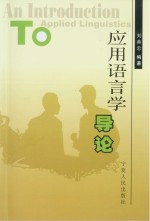
Self-preface 1
Chapter One An Overview of Applied Linguistics 1
1.1 Origins of the Term Applied Linguistics 1
1.2 Definition and Domains of Applied Linguistics 6
Chapter Two Applied Linguistics and Linguistics 17
2.1 Introduction 17
2.2 Historical Background 18
2.2.1 Growth of American Linguistics 20
2.2.2 Generative Linguistics 21
2.2.3 Current Generative Theory 24
2.3 Descriptive Syntax 30
2.4 Functional and Typological Theories 31
2.5 Anthropological Linguistics and Sociolinguistics 35
2.6 Linguistic Research and Applied Linguistics 39
2.6.1 Phonetics and Phonology 41
2.6.2 Morphology 41
2.6.3 Syntax 42
2.6.4 Semantics and Pragmatics 44
2.7 Sociolinguistics and Discourse Analysis 46
2.8 Conclusion 51
Chapter Three Applied Linguistics and the Teacher Profession 53
3.1 Study of Languages and Language Teaching 53
3.1.1 Early History 53
3.1.2 The Twentieth Century 54
3.2 Focus on the Language Learner:Motivation, Styles and Strategies 63
3.2.1 Introduction: Learner Characteristics 63
3.2.2 Characteristics outside the Teacher’s Control 64
3.2.3 Motivation 65
3.2.4 Learning Styles 72
3.2.5 Learner Strategies 75
3.2.6 Pedagogical Implications: the Intersection of Motivation,Styles and Strategies 87
3.2.7 The Use of Style and Strategy Surveys 88
3.2.8 Conclusion 89
3.3 Language Teacher Education and Development:Learning Teaching 90
3.3.1 Introduction 90
3.3.2 Models of Teacher Education 93
3.3.3 Qualifications and Professional Development:the Public Side 97
3.3.4 The BATQI Framework 99
3.3.5 Methods of Teacher Preparation 100
3.3.6 Training the Trainers 103
3.3.7 Research on Teacher Development 104
3.3.8 Language and the Language Teacher 108
3.3.9 Conclusion 110
3.4 The Language Classroom: Where It All Happens 110
3.4.1 Introduction 110
3.4.2 Systematic Observation 115
3.4.3 Interpretive Approaches 119
3.4.4 Organizational Issues 121
3.4.5 Feedback 124
3.4.6 Research by Whom? 128
3.4.7 The Ethnography of Language Classrooms 129
3.4.8 Conclusion 130
3.5 Language Testing and Evaluation 131
3.5.1 Introduction 131
3.5.2 Language Testing and Applied Linguistics 133
3.5.3 Current Trends in Language Testing 136
3.5.4 Validity and Reliability in Testing 141
3.5.5 Reliability, Item-Response Theory, and Computers in Language Testing 148
3.5.6 Project Evaluation 150
3.5.7 Conclusion 151
Chapter Four Applied Linguistics and Computer Application 154
4.1 Introduction 154
4.2 Computer Applications in Linguistics 156
4.3 The Computer as a Research Tool for Linguistic Analysis 159
4.3.1 Text-Related Research 160
4.3.2 Statistical Analyses in Applied Linguistics 166
4.4 Computer Applications for Language Learning and Teaching 168
4.4.1 Research on CALL Effectiveness 170
4.4.2 CALL Innovations 172
4.4.3 Developments in Writing, Reading, Language Arts,and Second-Language Instruction 175
4.4.4 Ongoing Problems with CALL 177
4.5 Computational Linguistics 178
4.6 Conclusion 184
Chapter Five Becoming an Applied Linguist 186
5.1 Introduction 186
5.2 Constraints on the Training of Applied Linguists 189
5.3 Linguistics 191
5.4 Language and Mind 198
5.5 Language and Society 200
5.6 Literacies and Tools 202
5.7 The Interaction of Knowledge Domains 208
5.8 Conclusion 211
Bibliography 216
- 《钒产业技术及应用》高峰,彭清静,华骏主编 2019
- 《现代水泥技术发展与应用论文集》天津水泥工业设计研究院有限公司编 2019
- 《英汉翻译理论的多维阐释及应用剖析》常瑞娟著 2019
- 《数据库技术与应用 Access 2010 微课版 第2版》刘卫国主编 2020
- 《区块链DAPP开发入门、代码实现、场景应用》李万胜著 2019
- 《虚拟流域环境理论技术研究与应用》冶运涛蒋云钟梁犁丽曹引等编著 2019
- 《当代翻译美学的理论诠释与应用解读》宁建庚著 2019
- 《第一性原理方法及应用》李青坤著 2019
- 《物联网导论》张翼英主编 2020
- 《程序逻辑及C语言编程》卢卫中,杨丽芳主编 2019
